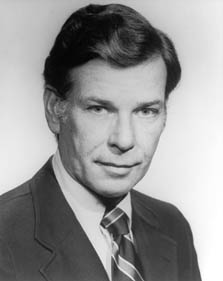
Governors' Papers Project
 |
Maryland State Archives Governors' Papers Project |
![]()
Governor Harry Hughes
 Harry Roe Hughes
was elected fifty-seventh Governor of the State of Maryland in
1978 and was re-elected in 1982. In each of these elections he
received more than 700,000 votes, a total unmatched by any other
gubernatorial candidate in Maryland history. His 71 percent of
the vote in the 1978 election represented the greatest margin of
victory by any contender for the governorship in this century. In
his 1982 re-election, he received 62 percent of the vote and
carried Baltimore City and 19 of the state's 23 counties.
Harry Roe Hughes
was elected fifty-seventh Governor of the State of Maryland in
1978 and was re-elected in 1982. In each of these elections he
received more than 700,000 votes, a total unmatched by any other
gubernatorial candidate in Maryland history. His 71 percent of
the vote in the 1978 election represented the greatest margin of
victory by any contender for the governorship in this century. In
his 1982 re-election, he received 62 percent of the vote and
carried Baltimore City and 19 of the state's 23 counties.
Governor Hughes became chief executive after extensive service in the General Assembly and in the state cabinet. He had served four years as a member of the House of Delegates, twelve as a state senator, and six as Secretary of Transportation. He assumed the governorship at a critical time in Maryland history. Public confidence in the government had been shaken by criminal prosecution of several elected state officials. In addition, as reflected by a survey showing the loss of more than 40,000 manufacturing jobs in the mid-1970s, the state economy had sunk to an advance stage of deterioration. Governor Hughes pledged to work for restoration of public faith in the political process and to dedicate greater state effort to revitalizing the economy.
Dramatic changes from the past marked his first term. Declaring a belief in the supremacy of principle over personality, he emphasized the role of the General Assembly as the policy-making arm of government and the role of the Governor as that of implementing that policy, initiating proposals on his own and in partnership with legislative leaders, and conscientiously exercising his constitutional budgetary and appointive powers.
Against this background, the first four years of the Hughes Administration brought dramatic improvement in the condition of the state. An aggressive economic development program was launched. Citizens and local government benefited from the most massive tax relief program ever undertaken by a Maryland governor and legislature. To overhaul a long-neglected corrections system, the biggest prison construction program in state history was initiated.
In addition, nationally recognized programs were adopted for the disposal of low-level nuclear and toxic wastes. One of the most vigorous programs in the nation was enacted to combat drunk driving, significantly reducing loss of life on streets and highways. After several defeats under sponsorship by previous administrations, legislation was adopted to consolidate an antiquated, politics-ridden Baltimore City Court system. Services to elderly citizens were greatly expanded.
Highlights of Governor Hughes's second term includes his campaign to save the Chesapeake Bay from centuries of pollution and abuse. Mustering widespread popular support for this program, he successfully enlisted the aid of his fellow governors from Virginia and Pennsylvania, the mayor of the District of Columbia, and the federal government. More than 700 leaders of government, environmental groups, and the business community packed the George Mason University auditorium in Fairfax, Virginia, for a 1983 conference to unveil the save-the-Bay program.
Also featured during the second Hughes's term were a year-long 1984 celebration of Maryland's 350th anniversary, the emergence of the Unversity of Maryland among the nation's top-ranked institutions of higher learning, a record increase in state support of public education, and the establishment of a National Institute for the Study and Prevention of Violence and Extremism at the Baltimore City campus of the University of Maryland.
Governor Hughes's concept for the institute on violence and extremism began taking shape shortly after his first inauguration. A group of leading citizens had brought to his attention a report of an upsurge in cross-burnings and synagogue desecrations. Shortly thereafter, in an address to the Montgomery County Bar Association, he publicly deplored such acts and called on all elected officials in Maryland to join him in speaking out against them. Later he successfully proposed state legislation providing more severe penalties for racially or religiously motivated violence and extremism, and he directed education and law enforcement officials to set up programs to combat the problem. Early in his second term he gained endorsement by the National Governors' Association of his proposal to establish the institute, and he provided initial funding for it in his budget for 1985.
Throughout his administration, Governor Hughes preserved Maryland's reputation for fiscal responsibility. Despite a prolonged national recession and accompanying reduction of a federal committment to programs affecting less fortunate citizens, he increased state funding for children's day care, alcoholism and drug-addiction treatment, the transfer of patients to residential settings from institutions for the retarded and mentally ill, and similar programs. In aid to families with dependent children, the state rose from a national ranking of thirty-sixth to twenty-ninth; in the level of benefits for unemployed workers, it rose from forty-second to twenty-sixth.
At the same time, Maryland retained its Triple-A bond rating from Moody's and from Standard and Poor's, a distinction that was shared by fewer than a dozen other states and that saved taxpayers millions of dollars through lower interest rates. Throughout these developments, the economy grew stronger.
Delegations headed by the Governor visited China, Europe, California, New York City, and Chicago to help attract new business and industry to the state. A special program was devised to familiarize local businesses with assistance available from the state for expansion within Maryland borders or for development of export trade. These efforts helped produce an average $1 billion a year -- four times the previous rate -- in the commitment of new capital for expansion or settlement of business in Maryland. Thousands of new jobs were created, especially among high-technology firms whose development in the Baltimore-Frederick-Washington triangle brought to that area the greatest concentration of electronic scientists and technicians in the nation. The state unemployment rate consistently ranged well below the national average. To help prepare a new generation of workers for the emerging computer and electronics industries and to ease the transition of many entering these industries from obsolescent crafts, Governor Hughes obtained legislative approval for the creation of a new Department of Employment and Training. By mid-decade, Maryland had become a leader in the rapidly developing field of high technology.
Governor Hughes was born in Easton, Maryland, a few miles from the Denton home of his parents, on November 13, 1926. He was educated in the public schools of Caroline County.
Enlisting at seventeen, he served a year-and-a-half with the U.S. Navy Air Corps in World War II. He later entered the University of Maryland and received a B.S. degree there in 1949. Before entering the University of Maryland he had attended Mercersburg Academy in Mercersburg, Pennsylvania, and Mount Saint Mary's College in Western Maryland. After receiving his undergraduate degree he entered the George Washington University School of Law and received his LL.B. degree in 1952. He was admitted to the practice of law in Maryland the same year and started practicing law in Denton in 1952.
Mr. Hughes was elected in 1954 to represent Caroline County in the Maryland House of Delegates and served one four-year term. In 1958 he was elected to the Senate, where he served three terms (1959-1970), first representing Caroline County and then, after reapportionment, the Upper Shore counties.
During his term in the Senate, Mr. Hughes held a number of leadership positions, including chairman of the Committee on Taxation and Fiscal Matters, a majority floor leader, chairman of the Committee on Finance, and chairman of the Commission to Study the State's Role in Financing Public Education.
In 1971, he was appointed to head the newly created Department of Transportation, serving in that post until May 1977, when he resigned in protest over the manner in which the Administration awarded a large construction management contract.
Governor Hughes is married to the former Patricia Donoho. They have two daughters, Ann, a teacher in special education, and Elizabeth, a practicing attorney in Baltimore.
Source: Maryland Manual, 1985-1986.
![]()
|
Tell Us What You Think About the Maryland State Archives Website!
|
© Copyright September 06, 2013 Maryland State Archives